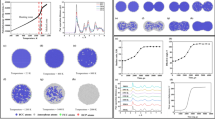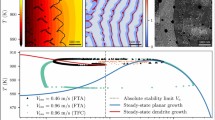Abstract
The dislocation-based modeling of the high-temperature creep of two-phased single-crystal superalloys requires input data beyond strain vs time curves. This may be obtained by use of in situ experiments combining high-temperature creep tests with high-resolution synchrotron three-crystal diffractometry. Such tests give access to changes in phase volume fractions and to the average components of the stress tensor in each phase as well as the plastic strain of each phase. Further progress may be obtained by a new method making intensive use of the Fast Fourier Transform, and first modeling the behavior of a representative volume of material (stress fields, plastic strain, dislocation densities…), then simulating directly the corresponding diffraction peaks, taking into account the displacement field within the material, chemical variations, and beam coherence. Initial tests indicate that the simulated peak shapes are close to the experimental ones and are quite sensitive to the details of the microstructure and to dislocation densities at interfaces and within the soft γ phase.











Similar content being viewed by others
References
[1] A. Jacques and P. Bastie: Philos. Mag., 2003, vol. 83, pp. 3005-27.
[2] L. Dirand, A. Jacques, J. Ph. Chateau-Cornu, T. Schenk, O. Ferry, and P. Bastie: Philos. Mag. 2012, vol. 93, pp. 1384-1412.
J. B. le Graverend, A. Jacques, J. Cormier, O. Ferry, T. Schenk, J. Mendez: Acta Mater., 2015, vol. 84, pp 65-79
[4] M. Wilkens: Kristall und Technik, 1976, vol. 11, pp. 1159-1169.
[5] T. Ungár, J. Gubicza, G. Ribárik and A. Borbély: J. Appl. Cryst., 2001, vol. 34, pp. 298-310.
[6] I. Groma:, Phys. Rev. B, 1998, vol. 57, pp. 7535-7542.
L. Balogh, G. Ribarik, and T. Ungar: J. Appl. Phys., 2006, vol. 100, p. 023512.
K. Huang: Proc. R. Soc. Lond. A, 1947, vol. 90, pp. 102-117.
[9] B. C. Larson and W. Schmatz: Phys. Rev. B, 1974, vol. 10, 2307-2314.
[10] R. I. Barabash, J. S. Chung and M. F. Thorpe: J. Phys.: Condens. Matter, 1999,11, pp. 3075-3090.
C.M. Weisbrook, V.S. Gopalaratnamb, A.D. Krawitza: Mater. Sci. Eng. A, 1995, vol. 201, pp. 134-142.
[12] M. P. Miller, and P R Dawson: Curr. Opin. Solid State Mater. Sci., 2014, vol. 18, 5, pp. 286-299.
[13] E. Demir, J. S. Park, M. P. Miller, P.R. Dawson: Comput. Methods Appl. Mech. Eng., 2013, vol. 265, 77, pp. 120-135.
[14] S. L.Wong, J. S. Park, M. P. Miller, P. R. Dawson: Comput. Mater. Sci., 2013, vol. 77, pp. 456-466.
F. Hofmann, S. Keegan, A. M. Korsunsky: Mater. Lett., 2012, vol.89, pp. 66-69.
[16] X. Song, F. Hofmann, and A. M. Korsunsky: Philos. Mag., 2010, vol. 90, 30, pp. 3999-4011.
[17] R. M. Suter, D. Hennessy, C. Xiao, U. Lienert: Rev. Sci. Instrum., 2006, vol. 77, 123905 doi:10.1063/1.2400017.
[18] N. Vaxelaire, H. Proudhon, S. Labat, C. Kirchlechner, J. Keckes, V. Jaques, S. Ravy, S. Forest, O. Thomas: New J. Phys, 2010, vol. 12, 035018.
I. A. Vartanyants and O. M. Yefanov: arXiv:1304.5335v1 [cond-mat.mes-hall], 2013
T. Mura: Micromechanics of defects in solids”, Mechanics of Elastic and Inelastic Solids, 1987, vol. 3, ISSN 0924-2163 Springer Netherlands, ISBN 978-90-247-3256-2. DOI 10.1007/978-94-009-3489-4, pp. 10–21.
[21] H. Moulinec, P. Suquet: Comput. Methods Appl. Mech. Eng., 1998, vol.157, pp. 69-94.
[22] J. C. Michel, H. Moulinec, P. Suquet: Comput. Methods Appl. Mech. Eng., 1999, vol. 172, pp.109-143.
[23] B. S. Anglin, R. A. Lebensohn, A. D. Rollett: Comput. Mater. Sci., 2014, vol. 87, pp. 209–217.
[24] S. Brisard, and L. Dormieux, Comput. Mater. Sci., 2010, vol. 49, pp. 663–671.
[25] S. Berbenni, V. Taupin, K. S. Djaka, and C. Fressengeas: Int. J. Solids Struct., 2014, vol. 51, pp. 4157-4175.
F. R. N. Nabarro, F. de Villiers: in Physics of Creep And Creep-Resistant Alloys, 1995, CRC Press. ISBN-13: 9780850668520 ISBN: 0850668522.
Roger C. Reed: The Superalloys: Fundamentals and Applications, 2008, Cambridge University Press, ISBN-10: 0521070112 ISBN-13: 978-0521070119.
A. Buchon: PhD Thesis, 1990, Université de Rouen.
[29] D. Blavette, A. Bostel: Acta Metall., 1984, vol. 32, 5, pp. 811–816.
[30] K. D. Liss, A. Royer, T. Tschentscher, P. Suortti, A. P. Williams: J. Synchrotron Radiat., 1998, vol. 5, 2, pp. 82-89.
[31] P. Suortti and T. Tschentscher: Rev. Sci. Instrum., 1995, vol. 66, pp.1798-1801.
[32] R. Bouchard, D. Hupfeld, T. Lippmann, J. Neuefeind, H.-B. Neumann, H. F. Poulsen, U. Rütt, T. Schmidt, J. R. Schneider, J. Süssenbach and M. von Zimmermann: J. Synchrotron Radiat, 1998, vol. 5, 2, p. 90-101.
A. Authier: Dynamical theory of X-Ray Diffraction, (IUCR Monographs on Crystal) 2004, Oxford University Press; Revised edition, ISBN-13: 978-0198528920), p. 447.
[34] H. A. Kuhn, H. Biermann, T. Ungár, and H. Mughrabi: Acta Metall. Mater., 1991, 39, 11, pp. 2783-2794.
[35] H. Biermann, M. Strehler, H. Mughrabi: Metall. Mater. Trans. A, 1996, Vol. 27, 4, pp 1003–1014.
[36] J. F. Ganghoffer, A. Hazotte, S. Denis, A. Simon: Scripta Metal. Mater., 1991, 25, pp. 2491-2496.
[37] L. Müller, T. Link, M. Feller-Kiepmeier: Scripta Metal. Mater., 1992, vol. 26, pp. 1297-1302.
A. Jacques, L. Dirand, J. P. Chateau, T. Schenk, O. Ferry, and P. Bastie: Adv. Mater. Res. 2010, vol. 278, pp. 48-53.
[39] P. Strunz, R. Gilles, D. Mukherji, A. Wiedenmann, R. P. Wahi, and J. Zrník: Mater. Struct. Chem., Biol., Phys. Technol., 1999, vol. 6, 2, pp.91-5.
[40] Q. Li and P. Anderson: Journal of Elasticity, 2001, vol. 64, pp. 237-245.
T. Gnaupel-Herold, P. C. Brand, and H. J. Prask: J. Appl. Crystallogr., 1998, vol. 31, pp. 929-35.
F. Willot and Y. P. Pellegrin: arXiv:0802.2488v1, 2008.
[43] S. Kaßbohm, W. H. Müller: Technishe Mechanik, 2003, vol. 23, 2-4, pp.178-83.
F. Diologent, P. Caron, T. d’Almeida, A. Jacques, P. Bastie: Nuclear Institude and Methods B (E-MRS 2002 Symposium on Synchrotron Radiation and Materials Science, 2003, vol. 200, pp. 346–351.
[45] X. Milhet, M. Arnoux, J. Cormier, J. Mendez, C. Tromas: Mater. Sci. Eng. A, 2012, Vol. 546, pp. 139-145.
Acknowledgments
The author would like to thank S. Berbenni (LEM3 Metz) for an introduction to FFT methods in elasticity and further useful discussions, Jonathan Cormier for comments on the metallurgy of superalloys, Martin Von Zimmermann and Uta Rütt (DESY), for their help with the triple-crystal diffractometer at DESY (BW5 and P07), Thomas Schenk and Mohamed Biskri for their contribution to the in situ experiments. The specimens were provided by A. Longuet (SNECMA, groupe SAFRAN). The travel costs of the experiments at DESY were funded by within the initiative “CALIPSO: EU Support of Access to Synchrotrons/FELs in Europe.”
Author information
Authors and Affiliations
Corresponding author
Additional information
Manuscript submitted May 8, 2016.
Rights and permissions
About this article
Cite this article
Jacques, A. From Modeling of Plasticity in Single-Crystal Superalloys to High-Resolution X-rays Three-Crystal Diffractometer Peaks Simulation. Metall Mater Trans A 47, 5783–5797 (2016). https://doi.org/10.1007/s11661-016-3793-z
Received:
Published:
Issue Date:
DOI: https://doi.org/10.1007/s11661-016-3793-z




